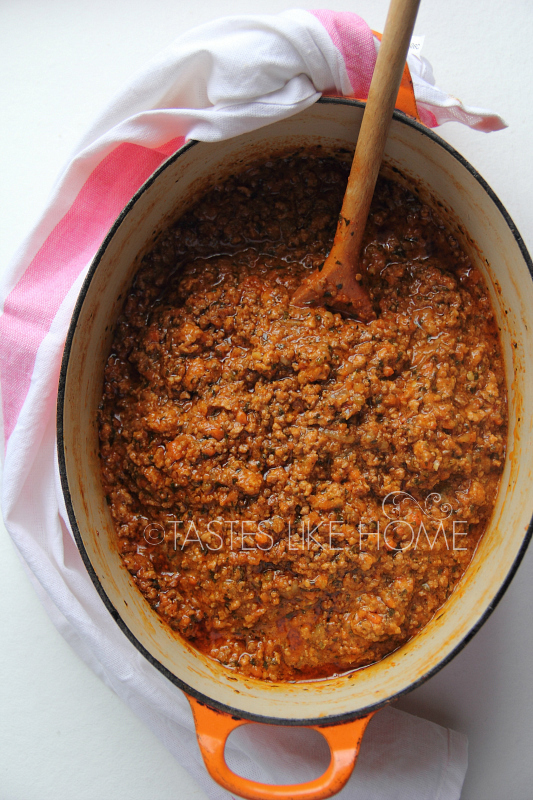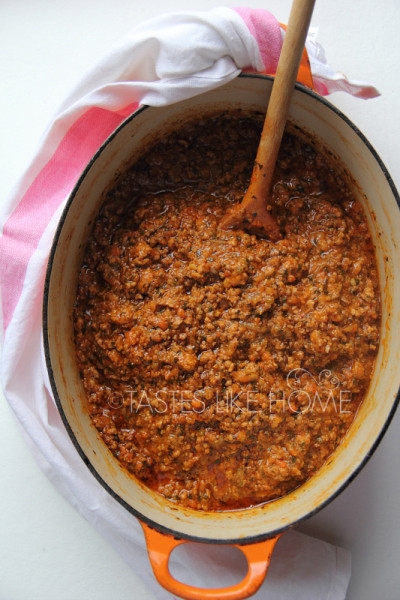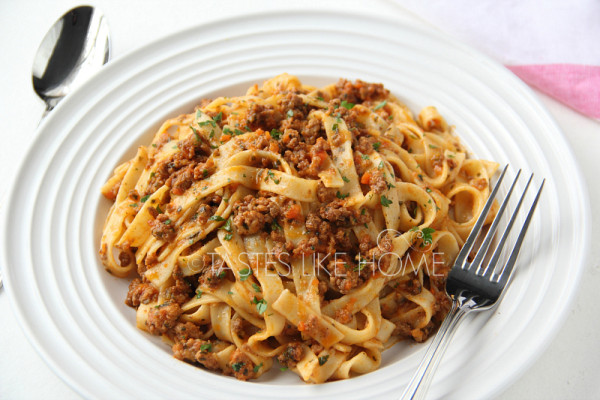 Hi Everyone, There is something sensual about slow-cooked food that you don’t get from some dishes that take far less time to cook. It is the type of food that engages you with deep layers of flavour and appealing textures. When you sit down to eat, it’s like a ritual. You’re not just eating, you are involved – the way you break the bread and press it into the rich velvety sauce of Pepperpot; how carefully you unwrap a Conkie or Pastelle and gaze upon it before you take that first bite, or how about that first sip of ice-cold mauby that has been ripening for a couple of days, with you faithfully brewing it daily. After your first sip, you hold out the glass staring into its depths as if willing it to reveal secrets to its maturity. Ragù Bolognese is a slow-cooked pasta meat sauce; it takes anywhere from 3 to 4 hours of cooking for the flavours to meld and develop, creating a rich, thick, creamy-like consistency. It invites you to slowly twirl your fork and chew even slower to savour all the nuances of its flavour profile.
Hi Everyone, There is something sensual about slow-cooked food that you don’t get from some dishes that take far less time to cook. It is the type of food that engages you with deep layers of flavour and appealing textures. When you sit down to eat, it’s like a ritual. You’re not just eating, you are involved – the way you break the bread and press it into the rich velvety sauce of Pepperpot; how carefully you unwrap a Conkie or Pastelle and gaze upon it before you take that first bite, or how about that first sip of ice-cold mauby that has been ripening for a couple of days, with you faithfully brewing it daily. After your first sip, you hold out the glass staring into its depths as if willing it to reveal secrets to its maturity. Ragù Bolognese is a slow-cooked pasta meat sauce; it takes anywhere from 3 to 4 hours of cooking for the flavours to meld and develop, creating a rich, thick, creamy-like consistency. It invites you to slowly twirl your fork and chew even slower to savour all the nuances of its flavour profile.
Ragù Bolognese is a thick, hearty, meaty pasta sauce of Italian origins in the city of Bologna. The long simmering makes the sauce very rich and savoury, and like many dishes, the combination of ingredients varies from one region to the other. However, the common thread that runs through this Italian favourite is that it’s meat-centred, the other ingredients, though important, are there to bolster not compete. Through the long cooking, the ingredients unite; they bond.
If you are looking for a dish that can stretch to feed a large family, or something that you can make to use in multiple ways throughout a week, then be sure to give this recipe a try. I know that the 3 to 4-hour cooking time may seem discouraging but don’t let it be, it is one of those situations where you almost set it and forget it. The sauce needs your attention at the beginning and at the end, the rest of the time, you can go about doing your other chores, or relax with a book or the telly. Oh, I must warn you, the major bother you will have is the aroma smelling up the house making you hungrier than ever. It’s a drawback of making this dish; what can I say? The Ragù Bolognese must be cooked with the lid off!
Before I head in to the recipe, let me share with you other ways you can use the sauce (other than tossing it with pasta): eat it with rice or boiled ground provisions, mashed potatoes, as the filling for Sloppy Joes, spooned over thick-sliced crusty toast or make lasagna.
The tossing of pasta with sauce is about creating a marriage, a union, and while I believe that the world would not come to an end if you don’t strictly follow the “rules” of pairing pasta and sauce, the recommended combinations do work exceptionally well. Here is a general guide:
- Shaped pastas such as farfalle (bow ties), fusilli (twists/springs) and conchiglie (shells) go well with different kinds of sauces; tiny pieces of meat, vegetables and beans are captured in the crevices or nestled in the twists.
- Short, tubular pastas like rigatoni (ridged edges), penne (ridged or smooth) or cavatappi (corkscrews/curly twists) go well with thick chunky sauces as well as creamy sauces. They are more likely to catch sauces in their openings.
- Long, thin pasta such as spaghetti, vermicelli, linguine pair well with light sauces whether oil or cream-based.
- Long flat ribbons like fettuccine, tagliatelle and pappardelle crave rich meaty sauces or heavy cream sauces.
The recipe below is my interpretation of Ragù Bolognese based on my personal taste. In the notes section I will share with you some information about ingredients used regionally in Italy that you could add to your version.
Ragù Bolognese
This quantity of cooked sauce will work for 2 pounds of dried, uncooked pasta. However, if you are one of those people who like a lot of sauce with pasta, then use 1¼ to 1½ pounds of pasta and when dressing the cooked pasta, do so with ¾ of the sauce and then top the mixture with the remaining sauce.
Pappardelle, tagliatelle or penne are pasta options for this sauce.
SPECIAL EQUIPMENT
A large heavy-bottomed pot
INGREDIENTS
- ¼ cup olive/vegetable/canola oil
- 1 pound ground beef
- 1 pound ground pork
- 4 tablespoons unsalted butter
- 2 tablespoons olive/vegetable/canola
oil
- 1½ cups finely chopped onions
- 1 cup finely chopped carrots
- ¾ cup chopped celery (1 cup if using
stalk celery)
- 1 tablespoon finely chopped fresh
sage
- ¼ cup finely chopped broad leaf
thyme
- 4 teaspoons finely minced garlic
- Minced hot pepper to taste
- Salt to taste
- ¼ teaspoon freshly grated nutmeg
- 3 tablespoons Worcestershire sauce
- 4 cups stock (beef, chicken or vegetable)
- 3 cups pureed tomatoes* (see notes below)
- 1 cup whole milk
- 2 fresh or dried bay leaves
- 1 cup heavy cream (I used canned evaporated milk)
- ¼ cup minced fresh parsley
DIRECTIONS
- Heat oil in pot over medium heat until smoking hot. Add minced meat to brown, breaking it up with a pot spoon. Let meat cook until it is no longer pink and there is no water. Remove from pot and set aside.
- Add butter to pot to melt along with 2 tablespoons of oil. Add onions, carrots, celery, sage, thyme, garlic and pepper; season with salt and pepper and toss well to mix. Reduce heat to low and let veggies and aromatics cook until softened, this will take 12 – 15 minutes (do not let the ingredients brown).
- Raise heat to medium-high, add back the meat and its drippings along with the grated nutmeg, Worcestershire sauce, salt and pepper to taste and toss to mix all the ingredients. Cook for 3 – 4 minutes.
- Add stock, tomatoes and milk along with bay leaves and give the pot a good stir scraping any bits at the bottom of the pot. Bring the pot to a boil, let cook for 5 minutes and then reduce to low simmer. Let cook for 3½ hours; give the pot a stir every half hour or whenever you pass by the stove.
- At the end of the 3½ hours a lot of the liquid should have reduced/evaporated and the sauce should moist but not watery. If you find that it is still watery, raise the heat to medium and let it cook for another 15 – 20 minutes until it is no longer watery but not dry. You will see some oil form at the top of the sauce. Now, the sauce should have some fat but if it is excessive, remove some by scooping it with a tablespoon.
- Add the cream and stir it briskly into the sauce to emulsify and bind in the sauce. This should take about 5 to 7 minutes. Taste the sauce and then season with salt and pepper to taste.
- Stir in the parsley.
- If not using the same day, cool the Bolognese completely and store in airtight containers in the refrigerator for up to a week. Or, portion in freezers bags, seal and freeze. Bring up to room temperature or defrost and then bring up to room temperature depending on how you stored the sauce.
- To serve, heat the ragù in a pan until just simmering and set aside. Cook pasta according to package instructions or your preference, drain reserving about ½ cup of the pasta cooking liquid. Add the pasta to the simmering sauce and toss well, adding the reserved water if the sauce is too thick. Cook together for 2 minutes or until the sauce is thick and the pasta is well coated.
- Serve hot (with grated Parmesan if you have/prefer).
NOTES
- Due to the length of time this sauce takes to cook, I found that it did not matter which type of oil was used.
- You can use 1 type of ground meat if that is all you have access to. For the ground beef, I used an 80/20 grind – 80% meat, 20% fat. This provided the right texture and end result for the sauce.
- If you don’t have sage but rosemary is available, then use the rosemary instead – same minced quantity.
- For the tomato puree – I roasted 3 pounds fresh tomatoes, removed the skins and then purred the tomatoes and measured the 3 cups. If you are going to use canned tomatoes, use whole tomatoes that you puree and then measure the 3 cups; do not use canned puree tomatoes, it will not give the necessary heft to the sauce.
Italian additions
- About 8 ounces of pancetta or dry cured bacon is rendered at direction # 2 and this fat is used to cook the vegetables and herbs.
- 1 cup of dry white wine is added at direction # 3 sans Worcestershire sauce and cooked down until most of it is absorbed.
- Regional variations include ragù being made with the meat of wild ducks, liver, pork sausage, lamb, rabbit and veal. Red wine is used to deglaze when the red meats are used.
Happy Cooking!
Cynthia







